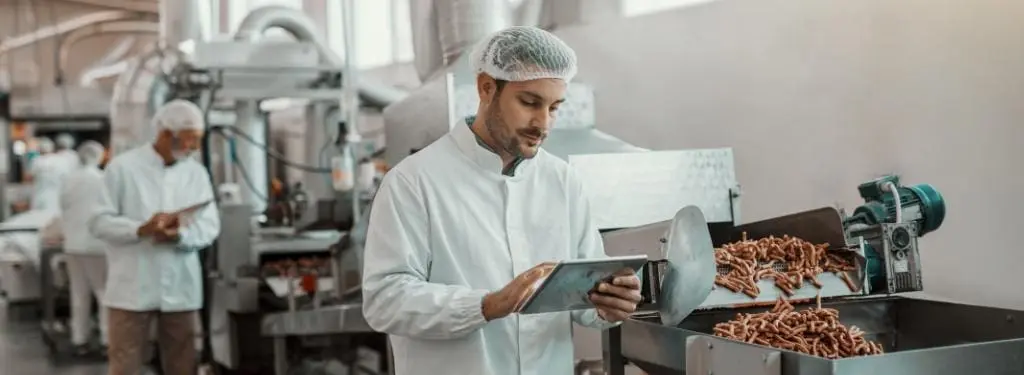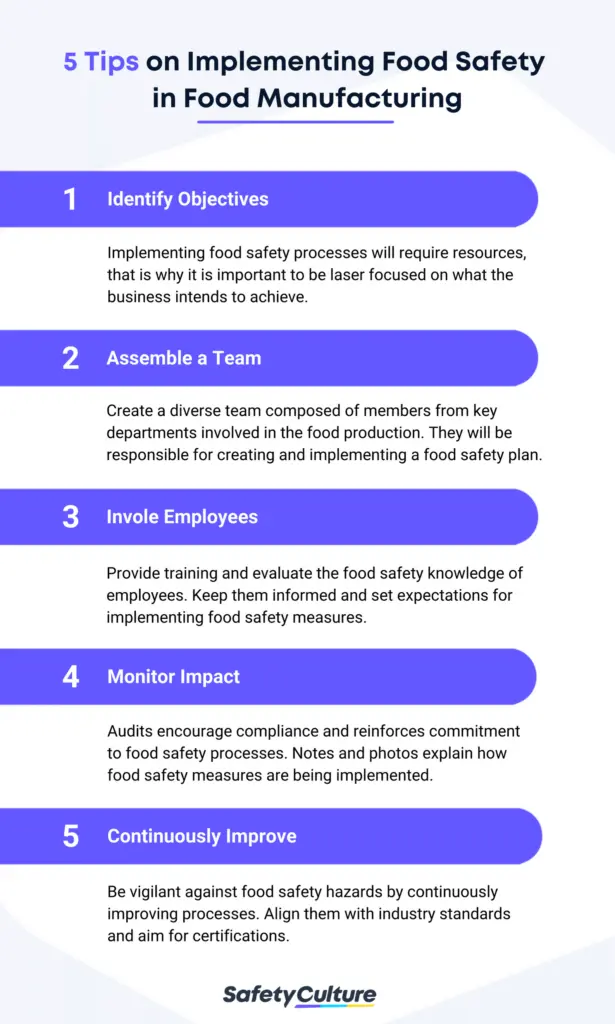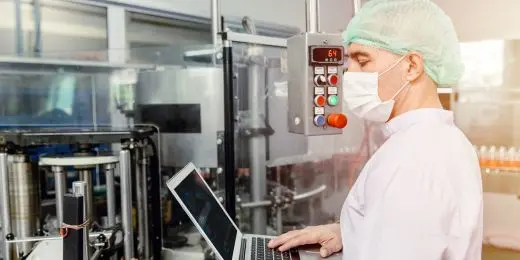Food Safety in Manufacturing
Maintaining the safety of food is crucial not only to the success of a food manufacturing business but also to the health of consumers. It entails a concerted effort and commitment to following food safety processes by all those involved in food production to keep food safe, prevent costly product recalls, and stay aligned with industry standards.
Collaboration within the organization and preparation at every step of production—from receiving the raw materials to the delivery of the finished product—can help in the effective implementation of food safety processes in the organization.
This article provides food safety guidelines, tips on how to effectively implement food safety processes and free software that can help streamline food safety processes.
Food Safety Guidelines
It is absolutely crucial for food manufacturing companies to practice food hygiene and food safety to not only keep the business running, but to also stay compliant with Good Manufacturing Procedures (GMP) for food and to protect end customers and employees in the kitchen. To help guide manufacturers, various food regulatory bodies have provided food safety regulations and standards. Among these are the following:
Cleaning & Sanitation
Everyday our hands pick up various types of microorganisms, some are dangerous and can lead to disease Which is why everyone involved in food production should observe the following hygiene practices:
- Washing hands before handling and preparing food
- Surfaces and equipment should be washed and sanitized with hot, soapy water before and after use
- Rinsing fresh raw materials under running water
- All areas involved in food production and preparation should be free of insects, pests, and other animals to avoid contamination.
For food manufacturing companies that involves slaughtering of animals, the same standards should be applied but with extra measures such as:
- Use personal protective gear to protect against on-going diseases caught from animals (e.g., Avian influenza)
- Change clothes after slaughtering
- Remove feces and keep away from areas where food growing, preparation, and storage is done.
Proper Storing & Organization
Food contamination can occur anytime across the whole manufacturing process. Which is why it is important that proper storing and organization is practiced on site. One way to do it is to properly separate raw food, as they can contain dangerous microorganisms. This applies not only during cooking but in all phases of food preparation and slaughtering. To prevent cross-contamination, consider doing the following:
- Separate raw meat, poultry, and seafood from other foods
- Use separate equipment and utensils (e.,g knives, cutting boards)
- Use containers with lids to avoid contact between raw and prepared foods
Another thing to consider is how harmful substances are being kept. For example, cleaning chemicals should be kept away from where equipment, utensils, and raw materials are stored.
Food Safety Temperatures
When it comes to the food safety temperatures, two things should be considered: 1) safe cooking temperatures; and 2) safe storing temperatures.
Cooking food at the right temperature can kill dangerous microorganisms such as salmonella, listeria and other dangerous bacteria that can cause foodborne illnesses. Safe cooking temperatures vary depending on the type of food, but below are some common foods that require strict time and temperature control for safety (called TCS food):
| Minimum Internal Temperature | Food Type |
| 165°F | Poultry, stuffing, casseroles, reheat food, leftovers |
| 160°F | Ground meats and egg dishes |
| 145°F | Fresh beef, veal, lamb, pork, ham, and fish with fins |
| 135°F | Fruits, vegetables, grains, legumes (for hot holding) |
To keep food safe for consumption, below are general guidelines for cooking in safe temperatures:
- Use a food thermometer to ensure foods are cooked within safe internal temperature
- If no thermometer is present, check color and texture as an indicator if safely cooked
- Microwave food thoroughly by following recommended cooking and standing times and using food thermometer to ensure it reaches 165°F
When it comes to chilling or refrigerating food, a certain temperature should be maintained to prevent the growth and spread of microorganisms. Storage practices can vary greatly depending on the type of food product. It is best to become familiar with different food storage practices, some of which are the following:
- Do not leave cooked food at room temperature for more than 2 hours
- Refrigerate or freeze perishable food within 2 hours
- Always check storage directions on labels and be alert for signs of spoilage
- Thaw frozen food in the refrigerator, cold water, or in the microwave. Avoid thawing on the counter to prevent bacteria multiplying quickly once food reaches room temperature
- Keep refrigerators and freezers at proper temperatures and check periodically
Use of Safe Water and Care Selection of Raw Materials
Raw materials including water and ice may contain dangerous microorganisms and chemicals. This can be prevented with simple measures such as careful selection of raw materials and ensuring water is safe before using for food preparation. Below are tips you may consider in ensuring water is safe:
- Boiling, chlorination, and filtration
- Covering tanks and other receptacles with netting to prevent insects from breeding in it
Quality Checks
Doing regular quality checks will help ensure that health and safety standards are being followed throughout the entire manufacturing process. It helps management identify defective or contaminated food products on the onset before distribution, and non-conformances to food safety regulations.
Improve your EHS Management
Cultivate a safe working environment and streamline compliance with our EHS solutions.
Explore now5 Tips on Implementing Food Safety Processes in Manufacturing
1. Identify Objectives & Scope
- It is a challenge to incorporate food safety processes in food manufacturing that is why it is important to be laser-focused and know what the business intends to achieve.
- Is the drive for food safety implementation due to:
- a response to food safety incident or PR/ brand damage that occurred
- product recall
- preparation for an upcoming inspection from the regulator (i.e. FDA inspection)
- achieve certification to win new business (FSSC 22000, BRC)
- defend against vulnerabilities or threats to food safety by introducing food safety methods (VACCP, TACCP)
- need to create a food safety framework applicable to the business (HACCP, ISO 22000)
2. Assemble a team responsible for a food safety plan
- Diversity is key. Food safety is a complex operational exercise and requires expertise across various teams and functions to be effective. Include expertise from safety, management, production, logistics, quality, and other key teams that will contribute to the formation of feasible food safety processes.
- The formed team should understand where the organization currently stands when it comes to food safety and come up with a gameplan. The team can gather data through risk assessments to help determine how the organization should implement food safety.
3. Involve employees
- Cascade the directive and explain to the employees the company’s objective for implementing these processes (regulatory compliance, aim for certification, etc) and how can the employees contribute to help make food safety work.
- Encourage employee feedback, particularly from those working in the production area since their experience will be invaluable for the effective implementation of food safety.
- Provide food safety training during employee onboarding, give refresher training courses, and conduct training evaluation for employees to gauge how much was learned and to keep them updated on changes regarding food safety.
- Keeping employees informed, setting timelines and expectations, and preparing them by providing trainings will empower employees and help streamline the implementation of food safety processes.
4. Monitor impact and review implementation
- Conduct regular audits to record how food safety is being practiced and include measurable observations. This will encourage compliance and reinforce commitment to the processes and standards being implemented.
- Detailed notes and photos taken by internal auditors can help determine the impact of implementing food safety processes. Observing trends over time can help gauge how effective the processes are.
- Record keeping is a required facet of HACCP, one of the most common food safety framework. Find out tips on how to implement effective record keeping in food safety.
Create your own Food Safety Audit Template
Build from scratch or choose from our collection of free, ready-to-download, and customizable templates.
Browse Food Safety Audit Templates5. Aim for continuous improvement and certification, if necessary
- New hazards and threats to food safety are kept at bay by being vigilant through monitoring and continuously improving food production processes.
- Getting certified for food safety is advantageous because the institutions aligned with the food industry prefer partnerships with businesses that have existing food industry standards certification.
- Conducting internal audits and recognizing non-compliance with food safety standards will gauge eligibility for third-party certification. Here are some sample internal audit checklists to help determine if your food safety processes align with existing industry standards:




